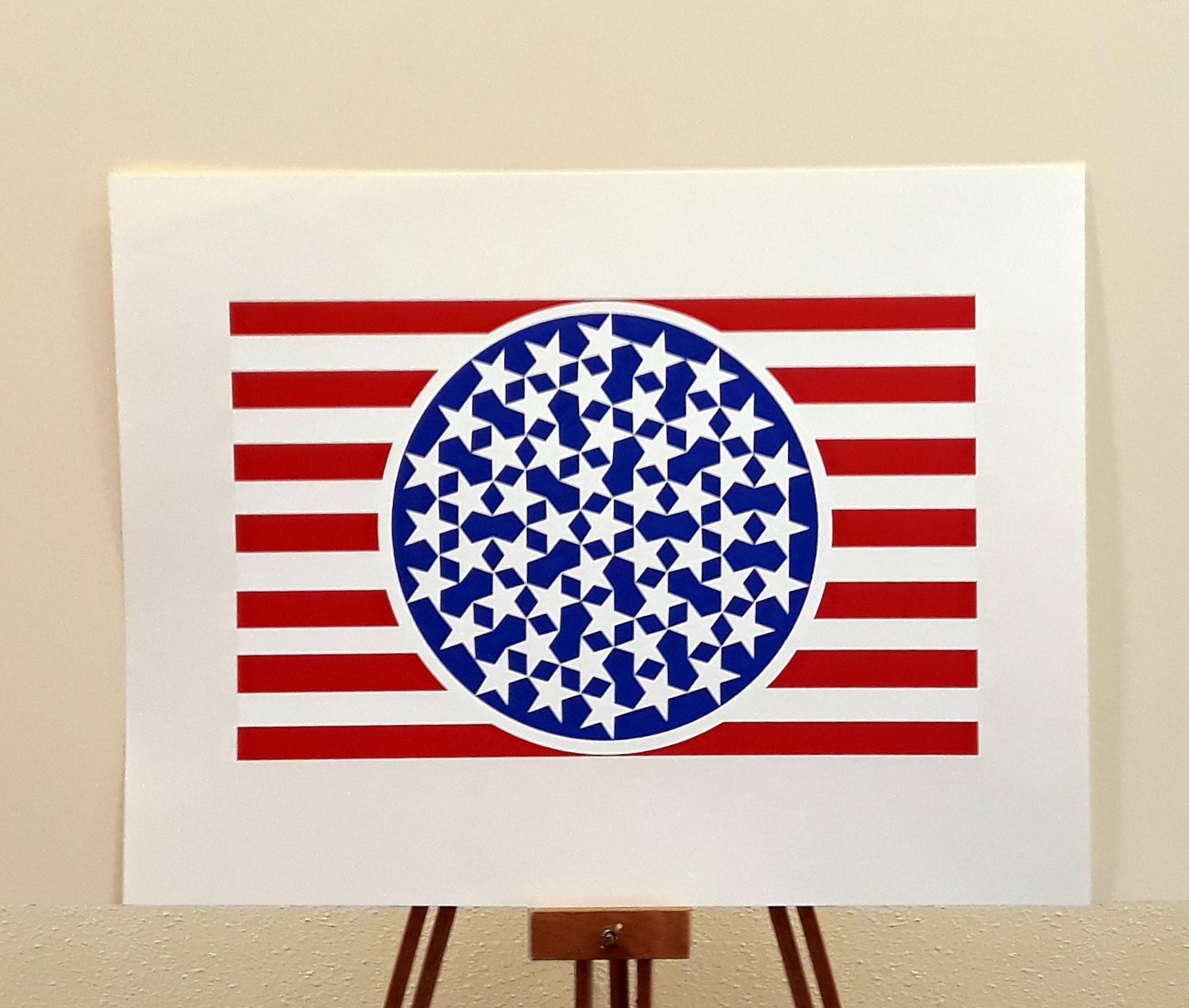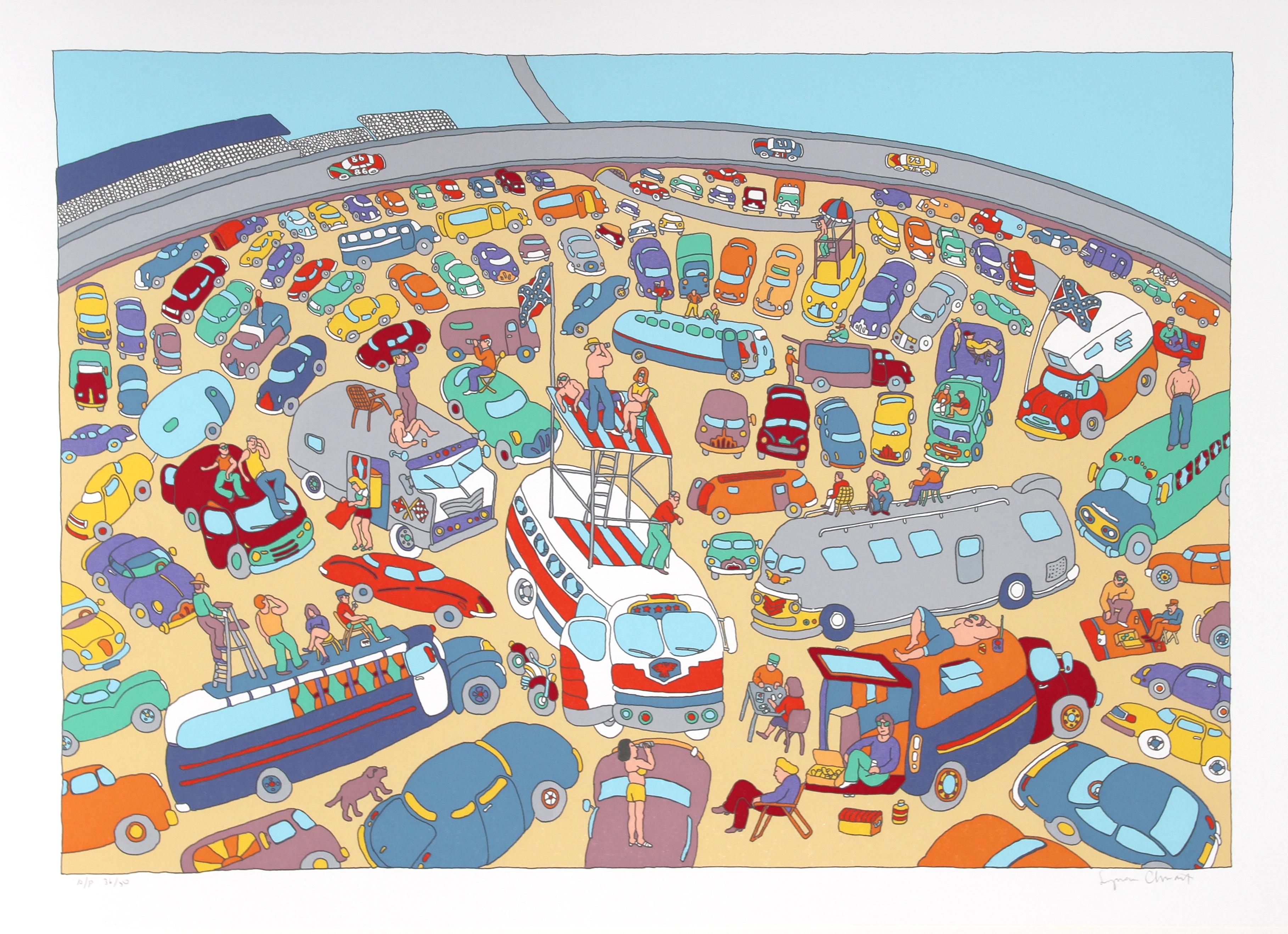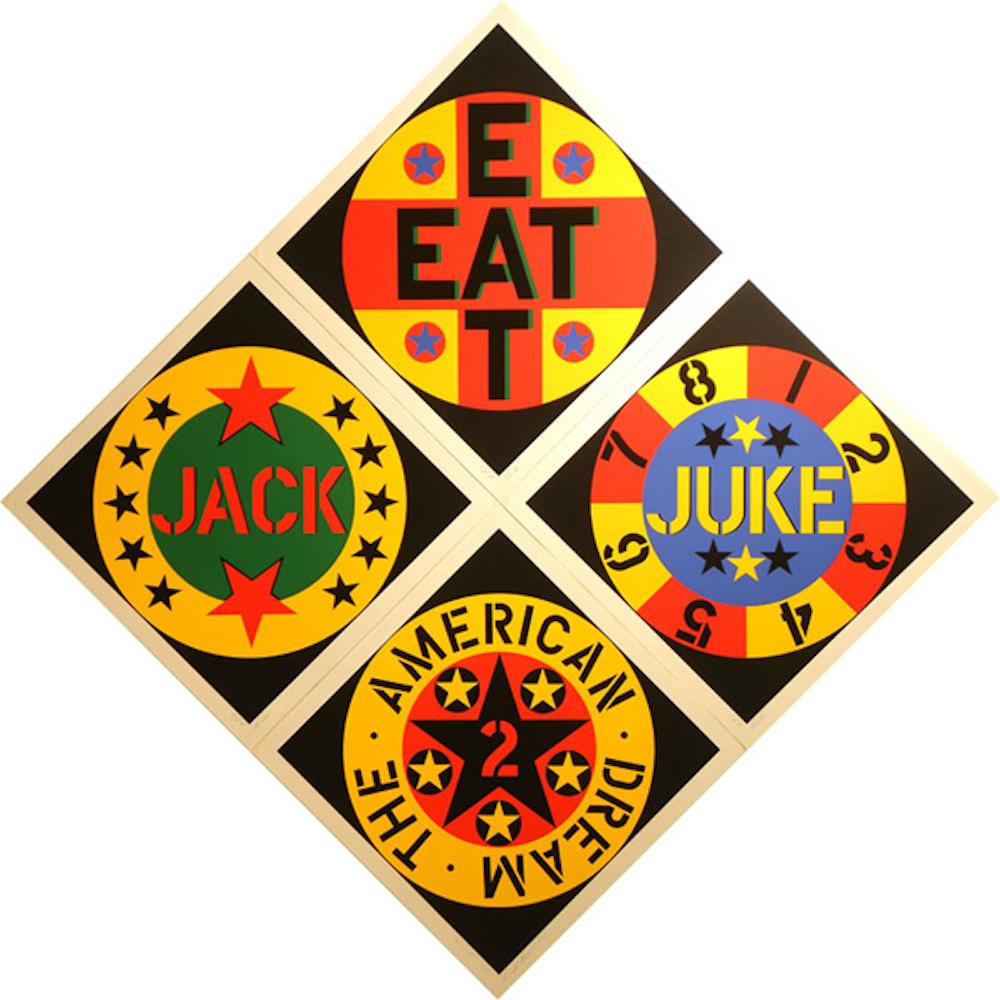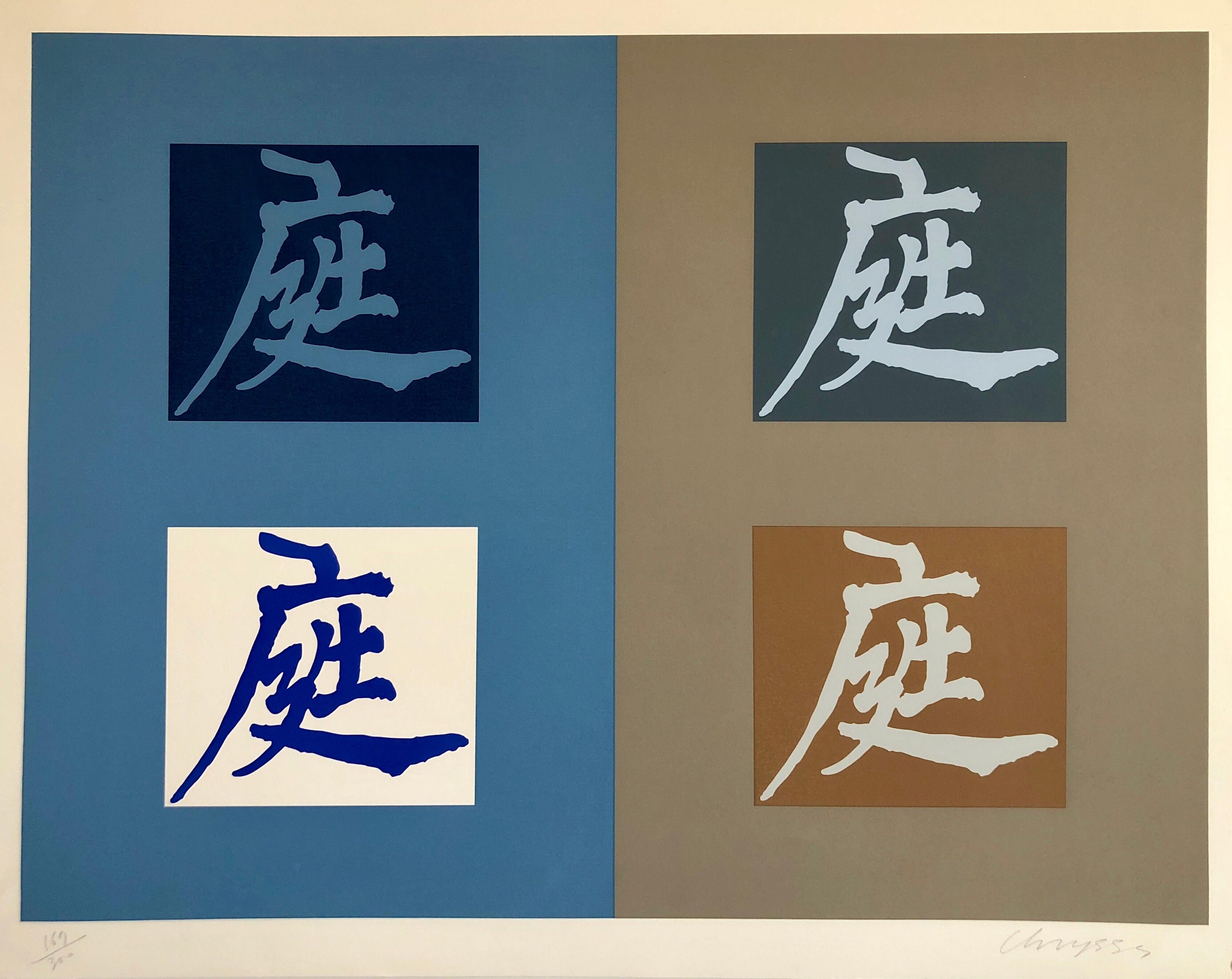Items Similar to Hi, from American Signs Portfolio
Want more images or videos?
Request additional images or videos from the seller
1 of 8
Robert CottinghamHi, from American Signs Portfolio2009
2009
About the Item
ROBERT COTTINGHAM
Hi, from American Signs portfolio, 2009
screenprint in colors, on wove paper, with full margins
40 1/8 x 39 1/8 in (101.9 x 99.4 cm)
signed, dated `2009' and numbered edition of 100 in pencil
Robert Cottingham B. 1935, BROOKLYN, NEW YORK Born in 1935 in Brooklyn, Robert Cottingham is known for his paintings and prints of urban American landscapes, particularly building facades, neon signs, movie marquees, and shop fronts. After serving in the U.S. Army from 1955 through 1958, he earned a BFA at Pratt Institute, Brooklyn, in 1963. Cottingham began his professional artistic career as an art director for the advertising firm Young and Rubicam in the early 1960s. Although he is typically associated with Photorealism, Cottingham never considered himself a Photorealist, but rather a realist painter working in a long tradition of American vernacular scenes. In this respect, his work often draws parallels to a number of American painters such as Stuart Davis, Charles Demuth, Edward Hopper, and Charles Sheeler.
Cottingham’s interest in the intersections of art and commerce derive from his career as an adman and the influence of Pop art. Many of his paintings convey an interest in typography and lettering, as well as an awareness of the psychological impact of certain isolated words and letters. In his facades, techniques from advertising, namely cropping and enlarging, often produce words of enigmatic or comical resonance such as “Art,” “Ha,” or “Oh.” Cottingham’s enlarged sense of scale is reminiscent of James Rosenquist’s work, while his interest in text suggests the influence of Robert Indiana and Jasper Johns. In general, Cottingham viewed his work as continuing the legacy of Pop artists such as Andy Warhol, who also had a background in advertising.
In 1964, Cottingham relocated to Los Angeles for work. There, inspired by the drastically different environment of the West Coast metropolis, he began to commit seriously to painting. Fascinated by Hollywood’s exaggerated glitz and the downtrodden atmosphere of the downtown, Cottingham saw in Los Angeles the relics of a bygone commercial heyday and desired to capture its kitschy and uncanny atmosphere, bathed in the near perpetual sunlight of Southern California.
In 1968, Cottingham ended his advertising career in order to devote all his time to painting. In the late 1960s, he started using photography in his practice, first as an initial reference point for his process. After selecting a photograph, he translates it into black-and-white drawings by projecting the image onto gridded paper, as a means of perfecting the tonal range between light and shadow. He often creates subsequent studies on paper using color. He finalizes the process by projecting either the original slide or any of the drawings onto a canvas and organizing the composition according to a grid. Another reason for Cottingham’s rejection of the Photorealist label is that he does not view his works as mere painterly translations of photographs or reproductions of reality.
He has been known to change the words in his facades to alter the meaning of the subject. His primary interest lies in the subject matter—the urban American vernacular—rather than the deployment of a photo-based technique. After spending a period of time in London from 1972 to 1976, Cottingham found the city’s signs and history too foreign and removed from his own interests, and returned to the United States to settle in rural Connecticut. During the late 1970s and 1980s, his urban cityscapes became more expansive, with more complex and broader views of storefronts, vistas, and entire neighborhoods. In the late 1980s and early 1990s, Cottingham expanded his iconography of American vernacular culture to include trains and railroad imagery. More recently, he has focused on images of vintage typewriters, a subject that first interested him in the late 1990s.
Cottingham taught at the Art Center College of Design, Los Angeles (1969–70), and the National Academy of Design, New York (1991). He was the artist in residence at Wesleyan University, Middletown, Connecticut (1987–92). His work has been included in significant group exhibitions, including Documenta, Kassel, West Germany (1972), and those at the Serpentine Gallery, London (1973); Centre national d’art contemporain, Paris (1974); Whitney Museum of American Art, New York (1978); a traveling exhibition at the National Museum of American Art (now Smithsonian American Art Museum), Washington, D.C. (1986); Samsung Museum of Modern Art, Seoul (2001); and Deutsche Guggenheim, Berlin (2009). Cottingham’s printed oeuvre was celebrated by a solo presentation at National Museum of American Art in 1998–99. The artist lives and works in western Connecticut.
- Creator:Robert Cottingham (1935, American)
- Creation Year:2009
- Dimensions:Height: 40 in (101.6 cm)Width: 39 in (99.06 cm)
- Medium:
- Movement & Style:
- Period:
- Condition:
- Gallery Location:New York, NY
- Reference Number:1stDibs: LU3261217673
About the Seller
5.0
Vetted Seller
These experienced sellers undergo a comprehensive evaluation by our team of in-house experts.
Established in 1996
1stDibs seller since 2013
654 sales on 1stDibs
Typical response time: 7 hours
- ShippingRetrieving quote...Ships From: New York, NY
- Return PolicyA return for this item may be initiated within 3 days of delivery.
More From This SellerView All
- La Blusa Rosa IIBy Julian SchnabelLocated in New York, NYLa Blusa Rosa II, 1995 "Sexual Spring-like Winter" is a large painterly work, created with layers of pink and resin by the art and film world's favorite enfant terrible, Julian Schn...Category
1990s Neo-Expressionist Abstract Prints
MaterialsScreen
- Art, from American Signs portfolioBy Robert CottinghamLocated in New York, NYROBERT COTTINGHAM Art, from American Signs portfolio, 2009 screenprint in colors, on wove paper, with full margins, 40 1/8 x 39 1/8 in (101.9 x 99.4 cm) signed, dated `2009' and...Category
Early 2000s Photorealist Abstract Prints
MaterialsScreen
- Star, from American Signs PortfolioBy Robert CottinghamLocated in New York, NYROBERT COTTINGHAM Star, from American Signs portfolio, 2009 screenprint in colors, on wove paper, with full margins, 40 1/8 x 39 1/8 in (101.9 x 99.4 cm) signed, dated `2009' and numbered edition of 100 in pencil -- Robert Cottingham B. 1935, BROOKLYN, NEW YORK Born in 1935 in Brooklyn, Robert Cottingham is known for his paintings and prints of urban American landscapes, particularly building facades, neon signs, movie marquees, and shop fronts. After serving in the U.S. Army from 1955 through 1958, he earned a BFA at Pratt Institute, Brooklyn, in 1963. Cottingham began his professional artistic career as an art director for the advertising firm Young and Rubicam in the early 1960s. Although he is typically associated with Photorealism, Cottingham never considered himself a Photorealist, but rather a realist painter working in a long tradition of American vernacular scenes. In this respect, his work often draws parallels to a number of American painters such as Stuart Davis, Charles Demuth, Edward Hopper, and Charles Sheeler. Cottingham’s interest in the intersections of art and commerce derive from his career as an adman and the influence of Pop art. Many of his paintings convey an interest in typography and lettering, as well as an awareness of the psychological impact of certain isolated words and letters. In his facades, techniques from advertising, namely cropping and enlarging, often produce words of enigmatic or comical resonance such as “Art,” “Ha,” or “Oh.” Cottingham’s enlarged sense of scale is reminiscent of James Rosenquist’s work, while his interest in text suggests the influence of Robert Indiana and Jasper Johns. In general, Cottingham viewed his work as continuing the legacy of Pop artists such as Andy Warhol, who also had a background in advertising. In 1964, Cottingham relocated to Los Angeles for work. There, inspired by the drastically different environment of the West Coast metropolis, he began to commit seriously to painting. Fascinated by Hollywood’s exaggerated glitz and the downtrodden atmosphere of the downtown, Cottingham saw in Los Angeles the relics of a bygone commercial heyday and desired to capture its kitschy and uncanny atmosphere, bathed in the near perpetual sunlight of Southern California. In 1968, Cottingham ended his advertising career in order to devote all his time to painting. In the late 1960s, he started using photography in his practice, first as an initial reference point for his process. After selecting a photograph, he translates it into black-and-white drawings by projecting the image onto gridded paper...Category
Early 2000s Photorealist More Prints
MaterialsScreen
- Fox, from American Signs portfolioBy Robert CottinghamLocated in New York, NYROBERT COTTINGHAM Fox, from American Signs portfolio, 2009 screenprint in colors, on wove paper, with full margins 40 1/8 x 39 1/8 in (101.9 x 99.4 cm) signed, dated `2009' a...Category
Early 2000s American Modern Prints and Multiples
MaterialsScreen
- Champagne, from American Signs portfolioBy Robert CottinghamLocated in New York, NYROBERT COTTINGHAM Champagne, from American Signs portfolio, 2009 screenprint in colors, on wove paper, with full margins 40 1/8 x 39 1/8 in (101.9 x 99.4 cm) signed, dated `2...Category
Contemporary More Prints
MaterialsScreen
- Drinks, from American Signs portfolioBy Robert CottinghamLocated in New York, NYROBERT COTTINGHAM Drinks, from American Signs portfolio, 2009 screenprint in colors, on wove paper, with full margins 40 1/8 x 39 1/8 in (101.9 x 99.4 cm) signed, dated `2009...Category
Early 2000s Photorealist More Prints
MaterialsScreen
You May Also Like
- New Glory BannerBy Robert IndianaLocated in Winterswijk, NLLimited Edition print from "The American Dream" Series Pop Art Serigraph Published in 1963 by Multiples, Inc. as a felt banner Robert Indiana New Glory Banner...Category
1990s Pop Art More Prints
MaterialsScreen
- "Daytona 500", circa 1979, Serigraph by Seymour ChwastBy Seymour ChwastLocated in Long Island City, NYArtist: Seymour Chwast, American (1931 - ) Title: Daytona 500 Year: circa 1979 Medium: Serigraph, signed and numbered in pencil Edition: 250 Image Size:...Category
1970s Pop Art More Prints
MaterialsScreen
- "New York City Center 25th Anniversary"By Robert IndianaLocated in New York, NYRobert Indiana "New York City Center 25th Anniversary" New York City Center, 1968 Silkscreen Poster 35 x 25 inches Unsigned This poster is printed on...Category
1960s Pop Art Abstract Prints
MaterialsScreen
- "The American Gas Works", from the American Dream Portfolio by Robert IndianaBy Robert IndianaLocated in Long Island City, NYArtist: Robert Indiana, American (1928 - 2018) Title: The American Gas Works from the American Dream Portfolio Year: 1961-62 (1997) Medium: Serigraph Edition Size: 395 Image Size: 17...Category
1960s Pop Art More Prints
MaterialsScreen
- American Dream #2By Robert IndianaLocated in Miami, FLTECHNICAL INFORMATION: Robert Indiana American Dream #2 1982 Screenprint on 4 separate sheets 26 3/4 x 26 3/4 in. each sheet (77 1//2 x 77 1/2 in. overall) A.P. of 9/15 (Artist's Pr...Category
1980s Pop Art Abstract Prints
MaterialsScreen
- 1980's Large Silkscreen Chinese Characters Serigraph Pop Art Print ChinaBy Chryssa Vardea-MavromichaliLocated in Surfside, FLChryssa Vardea-Mavromichali (Greek: Χρύσα Βαρδέα-Μαυρομιχάλη; December 31, 1933 – December 23, 2013) was a Greek American artist who worked in a wide variety of media. An American art pioneer in light art and luminist sculpture widely known for her neon, steel, aluminum and acrylic glass installations, she has always used the mononym Chryssa professionally. She worked from the mid-1950s in New York City studios and worked since 1992 in the studio she established in Neos Kosmos, Athens, Greece. Chryssa was born in Athens into the famous Mavromichalis family from the Mani Peninsula. one of her sisters, who studied medicine, was a friend of the poet and novelist Nikos Kazantzakis. Chryssa began painting during her teenage years and also studied to be a social worker.In 1953, on the advice of a Greek art critic, her family sent her to Paris to study at the Académie de la Grande Chaumiere where Andre Breton, Edgard Varese, and Max Ernst were among her associates and Alberto Giacometti was a visiting professor. In 1954, at age twenty-one, Chryssa sailed for the United States, arrived in New York and went to San Francisco, California to study at the California School of Fine Arts. Returning to New York in 1955, she became a United States citizen and established a studio in the city. Chryssa's first major work was The Cycladic Books preceded American minimalism by seventeen years. 1961, Chryssa's first solo exhibition was mounted at The Guggenheim. 1963, Chryssa's work was shown at the Museum of Modern Art in curator Dorothy Canning Miller's Americans 1963 exhibition. The artists represented in the show also included Richard Anuszkiewicz, Lee Bontecou, Robert Indiana, Richard Lindner, Marisol, Claes Oldenburg, Ad Reinhardt, James Rosenquist and others. 1966, The Gates to Times Square, regarded as "one of the most important American sculptures of all time" and "a thrilling homage to the living American culture of advertising and mass communications." The work is a 10 ft cube installation of two huge letter 'A's through which visitors may walk into "a gleaming block of stainless steel and Plexiglas that seems to quiver in the play of pale blue neon light" which is controlled by programmed timers. First shown in Manhattan's Pace Gallery, it was given to the Albright-Knox Art Gallery in Buffalo, New York in 1972. 1972, The Whitney Museum of American Art mounted a solo exhibition of works by Chryssa. That's All (early 1970s), the central panel of a triptych related to The Gates of Times Square, was acquired by the Museum of Modern Art between 1975 and 1979. 1973, Chryssa's solo exhibition at the Gallerie Denise René was reviewed for TIME magazine by art critic Robert Hughes before it went on to the Galleries Denise René in Düsseldorf and Paris. Other works by Chryssa in composite honeycomb aluminum and neon in the 1980s and 1990s include Chinatown, Siren, Urban Traffic, and Flapping Birds. Chryssa 60/90 retrospective exhibition in Athens in the Mihalarias Art Center. After her long absence from Greece, a major exhibition including large aluminum sculptures - cityscapes, "neon boxes" from the Gates to the Times Square, paintings, drawings etc. was held in Athens. In 1992, after closing her SoHo studio, which art dealer Leo Castelli had described as "one of the loveliest in the world," Chryssa returned to Greece. She found a derelict cinema which had become a storeroom stacked with abandoned school desks and chairs, behind the old Fix Brewery near the city center in Neos Kosmos, Athens. Using the desks to construct enormous benches, she converted the space into a studio for working on designs and aluminum composite honeycomb sculptures. The Athens National Museum of Contemporary Art, which was founded in 2000 and owns Chryssa's Cycladic Books, is in the process of converting the Fix Brewery into its permanent premises. Greek Exhibits, European Cultural Center of Delphi (Council of Europe). "Apollo's Heritage"(July 4, 2003 – July 30, 2003). Works by sixteen artists: Giorgio de Chirico, Salvador Dalí, Nikos Hadjikyriakos-Ghikas, Nikos Engonopoulos, Yannis Tsarouchis, Giorgos Sikeliotis, Takis, Arman, Fernando Botero, Chryssa, Dimitris Mytaras...Category
1980s Pop Art Abstract Prints
MaterialsScreen
Recently Viewed
View AllMore Ways To Browse
Vintage Train Signs
Vintage Commercial Signs
Vintage American Advertising
Typography Prints
Railroad Print
Vintage Art Rural
Original Neon Signs
Pop Art Vintage Screen
Vintage Neon Art
Neon Art Vintage
70s Screen
Vintage Neon Sign
Black And White Pencil Drawings Paris
Neon Text Art
Vintage Neon Light
70s Western
Neon 1980s
Vintage California Coast




